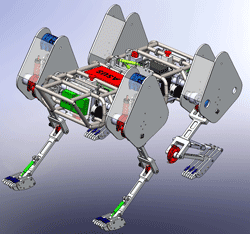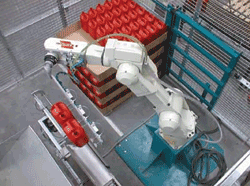Why robotics might be the most valuable activity in education today
BY MARIE PLANCHARD, Director of World Education Markets, Dassault Systèmes SolidWorks
www.solidworks.com
Kids don’t build things anymore. We buy our children toys. They use them. They break them. We throw the toys away. Meanwhile, many of a youth’s most meaningful experiences occur in the virtualworld. And while so many parents are attuned to the value of sports, and that’s great, creativity is too often overlooked. At least the kind that resembles engineering, a proficiency our nation’s future hinges on.

Optimizing a mobile robot’s navigation performance
BY MARK LOONEY, iSensor Application Engineer, Analog Devices
www.analog.com
Ground-based robots are typically used for missions where direct human involvement is too expensive, too dangerous, or just ineffective. Often, the robots must be able to operate autonomously, using navigation systems to monitor and control their motion when moving from one location to the next, and when accuracy in managing position and motion is key to useful, reliable autonomous operation.

The Allan variance curve (shown for an ADIS16265 — an iSensor MEMS device similar to the gyroscope currently used in the Seekursystem) can also help determine the optimal integration time for gyro sensing.
Sensing and motion ICs drive robotic applications
BY ROGER LEVINSON
Vice President and General Manager, Precision Products Group, Intersil
www.intersil.com
Robotics in various forms has stimulated the imagination of many science fiction writers as well as investment bankers over the last forty years. In applications such as computer-assisted surgery,automobile safety and auto-park systems robotics is becoming commonplace. Industrial automation, the early automation leader, has driven big advances in robotics/factory automation that aided both factory safety and production efficiency. Advances in these segments have been fueled by billions of dollars of investment in four major technology sectors: sensors, transducers, motors, and control electronics.

Sophisticated multiaxis robotic arms need several kinds of sensors.
Autonomous Cars: Driving the Future
People have long wanted vehicles that could drive themselves and engineers have been working on it since the car replaced the horse. Recently there have been great strides in autonomous cars. The Google cars, vehicles that can navigate using artificial-intelligence software, have driven over 1,000 miles without human intervention and more than 140,000 miles with only occasional human control.
The computer can react much faster than humans. It has 360º perception, doesn’t drink and drive, doesn’t get tired, and doesn’t text and drive. Autonomous vehicles may greatly reduce the number of accidents on the road, but when and if there is a accident, who is responsible, the owner of the vehicle or the makers of the software?
But the technology that drives autonomous vehicles is way ahead of the laws. Most current laws either require a human operator or assume the operator of the vehicle is human. Autonomous vehicles are still years from mass production, but they have already sparked discussion about how they will change society as a whole. Remember life before the Internet? The change is likely to be as profound.
Bryan DeLuca
For more on Project Robotics, visit www.electronicproducts.com/projectrobotics
T
Advertisement
Learn more about Digi-Key





